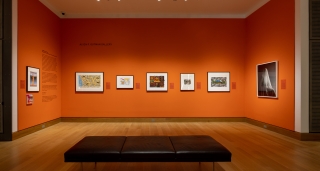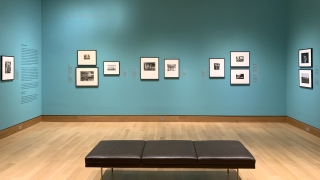Past Exhibitions
This Land: American Engagement with the Natural World explores artistic responses to the natural world by diverse American artists working from the early nineteenth century to the present. It is the first major installation of the museum’s historic American collection to be organized thematically, rather than chronologically. More significantly, it features not only Euro-American, African American, Latin American, and Asian American works but also, for the first time, traditional and contemporary Native American works hung alongside this early to contemporary "American" art. This collaboratively curated exhibition of approximately 160 works fills four galleries as it compels us to consider new perspectives on historical and contemporary art by diverse artists, Native and non-Native, and to reflect on our own relationship to place and land. How, for instance, have experiences of home and the natural world changed historically and in our own lifetimes? How have they already been impacted by unanticipated phenomena, such as the COVID-19 pandemic? What actions would help to provide all Americans a secure sense of home, in both the built and the natural environment?
The Tiger Cat
Thornton DialUndocumented Immigrants and the American Dream
A DREAM DeferredA DREAM Deferred: Undocumented Immigrants and the American Dream explores works of art that call attention to undocumented immigrants, whose livelihoods are in constant danger as they continue to live in the United States in hopes of better opportunities and to achieve the so-called American Dream. This exhibition focuses primarily on poster prints, which have become a popular and effective tool for spreading the word on injustices and reaching mass audiences.
A Space for Dialogue is a student-curated exhibition program that began in 2001. Hood Museum of Art interns create an installation drawn from the museum’s permanent collection by engaging with every aspect of curation, from doing research and selecting objects, to choosing frames and a wall color, to planning a layout and writing labels and a brochure, to giving a public talk. There have been over 100 A Space for Dialogue exhibitions on a wide variety of themes.
The John Kobal Foundation Collection
Photographs from Hollywood’s Golden EraComprising some 6,000 prints, the recently acquired John Kobal Foundation Collection represents the full range of Hollywood studio photographs taken from the 1920s through the 1960s. This installation offers a glimpse into this renowned collection, highlighting a small selection of portraits and photographs from film sets.
Abstracting Nature
Transcendent LandscapesTranscendent Landscapes: Abstracting Nature explores the environment as a subject in abstract art. Focusing on five monumental works by female painters, this exhibition studies the spiritual role landscapes play in painting and considers the way these works evoke metaphysical experiences for both the artist and the viewer.
A Space for Dialogue is a student-curated exhibition program that began in 2001. Hood Museum of Art interns create an installation drawn from the museum’s permanent collection by engaging with every aspect of curation, from doing research and selecting objects, to choosing frames and a wall color, to planning a layout and writing labels and a brochure, to giving a public talk. There have been over 100 A Space for Dialogue exhibitions on a wide variety of themes.
The melodrama of Southern Gothic literature has captivated many with its enthralling treatment of the grotesque. The exhibition Southern Gothic explores the complex and often macabre world of the Southeastern United States. This niche genre deals with racial tensions, Reconstruction, the Great Depression, and the ghostly remains of the Antebellum era. This exhibition explores works from artists who have captured the spirit of Southern Gothic in all its darkness—and light.
A Space for Dialogue is a student-curated exhibition program that began in 2001. Hood Museum of Art interns create an installation drawn from the museum’s permanent collection by engaging with every aspect of curation, from doing research and selecting objects, to choosing frames and a wall color, to planning a layout and writing labels and a brochure, to giving a public talk. There have been over 100 A Space for Dialogue exhibitions on a wide variety of themes.






